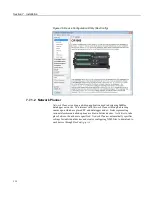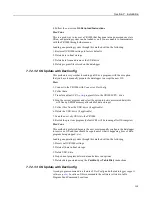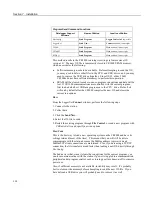
Section 7. Installation
on the
12V
terminals will change with CR1000 supply voltage.
Caution
Voltage levels at the
12V
and switched
SW12
terminals, and pin 8 on
the
CS I/O
port, are tied closely to the voltage levels of the main power supply.
For example, if the power received at the
POWER IN
12V
and
G
terminals is 16
Vdc, the
12V
and
SW12
terminals, and pin 8 on the
CS I/O
port, will supply 16
Vdc to a connected peripheral. If the connected peripheral or sensor is not
designed for that voltage level, it may be damaged.
7.5.4 Switched Unregulated Voltage (SW12 Terminal)
The
SW12
terminal is often used to power devices such as sensors that require 12
Vdc during measurement. Current sourcing must be limited to 900 mA or less at
20 °C. See table
Current Source and Sink Limits
(p. 103).
Voltage on a
SW12
terminal will change with CR1000 supply voltage. Two CRBasic instructions,
SW12()
and
PortSet()
, control the
SW12
terminal. Each instruction is handled
differently by the CR1000.
SW12()
is a processing task. Use it when controlling
power to SDI-12 and serial sensors that use
SDI12Recorder()
or
SerialIn()
instructions respectively. CRBasic programming using
IF THEN
constructs to
control
SW12
, such as when used for cell phone control, should also use the
SW12()
instruction.
PortSet()
is a measurement task instruction. Use it when powering analog input
sensors that need to be powered just prior to measurement.
A 12 Vdc switching circuit designed to be driven by a
C
terminal is available
from Campbell Scientific. It is listed in the appendix
Relay Drivers — Products
(p.
Note
SW12
terminal power is unregulated and can supply up to 900 mA at 20
°C. See table
Current Source and Sink Limits
(p. 103).
A resettable polymeric fuse
protects against over-current. Reset is accomplished by removing the load or
turning off the
SW12
terminal for several seconds.
The
SW12
terminal may behave differently under
pipeline
(p. 152)
and
sequential
(p.
modes. See
CRBasic Editor Help
for more information.
7.6
Grounding
Grounding the CR1000 with its peripheral devices and sensors is critical in all
applications. Proper grounding will ensure maximum ESD (electrostatic
discharge) protection and measurement accuracy.
7.6.1 ESD Protection
Reading List:
•
ESD Protection
(p. 105)
•
Lightening Protection
(p. 107)
ESD (electrostatic discharge) can originate from several sources, the most
common and destructive being lightning strikes. Primary lightning strikes hit the
CR1000 or sensors directly. Secondary strikes induce a high voltage in power
lines or sensor wires.
105
Summary of Contents for CR1000
Page 2: ......
Page 4: ......
Page 6: ......
Page 32: ......
Page 36: ......
Page 38: ......
Page 40: ......
Page 60: ...Section 4 System Quickstart Figure 16 PC200W View Line Graph 60 ...
Page 96: ......
Page 98: ...98 ...
Page 302: ......
Page 453: ...Section 8 Operation Figure 115 Using the Keyboard Display 453 ...
Page 456: ...Section 8 Operation Figure 118 Real Time Custom 456 ...
Page 457: ...Section 8 Operation 8 8 1 3 Final Memory Tables Figure 119 Final Memory Tables 457 ...
Page 458: ...Section 8 Operation 8 8 2 Run Stop Program Figure 120 Run Stop Program 458 ...
Page 460: ...Section 8 Operation Figure 122 File Edit 460 ...
Page 461: ...Section 8 Operation 8 8 4 PCCard Memory Card Display Figure 123 PCCard CF Card Display 461 ...
Page 478: ......
Page 506: ......
Page 536: ......
Page 636: ......
Page 642: ......
Page 644: ......
Page 676: ......
Page 677: ......
















































